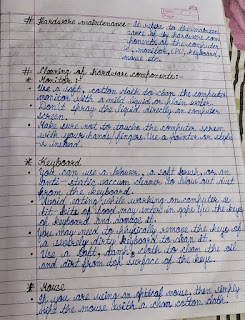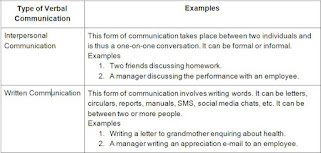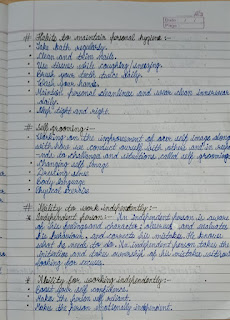INFORMATION AND COMMUNICATION TECHNOLOGY SKILL






COMMUNICATION SKILL
Q.1 Which of
the following is NOT an element of communication within the communication
process cycle?
|
|||
|
a) Channel |
b) Receiver |
c) Sender |
d) Time |
Q.2 You need
to apply leave at work? Which method of communication will you use?
|
|||
|
a) e-mail |
b) Poster |
c) Newsletter |
d)
Blog |
Q.3 By which
action can senders can not send their messages?
|
|||
|
a) Gestures |
b) Speaking |
c) Reading |
d) Writing |
Q.4 Which of the following is an example of
oral communication?
|
|||
|
a) Newspapers |
b) Letters |
c) Phone call |
d) e-mail |
Q.5 What are
the types of words we should use for verbal communication?
|
|||
|
a) Acronyms |
b) Simple |
c) Technical |
d) Jargons |
Q.6 Which of
these is a positive (good) facial expression?
|
|||
|
a) Frowning
while concentrating |
b) Maintaining
eye contact |
c) Smiling
continuously |
d) Rolling
up your eyes |
Q.7 Which of
these is NOT an appropriate non-verbal communication at work?
|
|||
|
a) Tilting
head a bit to listen |
b) Sitting
straight |
c) Talking at
moderate speed |
d) Keeping
hands in pockets while talking |
Q.8 Which of
the following statement is true about communication?
|
|||
|
a) 50% of our
communication is non-verbal |
b) 20%
communication is done using body movements, face, arms, etc. |
c) 5%
communication is done using voice, tone, pauses, etc. |
d) 7% communication is done using words. |
Q.9 Which of
the following are effective components of a good feedback?
|
|||
|
a) Detailed
and time consuming |
b) Direct and
honest |
c) Specific |
d)
Opinion-based |
Q.10 Which
of these is NOT a common communication barrier?
|
|||
|
a) Linguistic
barrier |
b) Interpersonal
barrier |
c) Financial
barrier |
d)
Organisational barrier |
Q.11 Which of these are ways to overcome
communication barriers?
|
|||
|
a) Respecting
each other’s differences |
b) Using a
translator |
c) Not
communicating at all |
d) Using your own language for comfort |
Q.12 In
which of the following, the underlined word is an adjective?
|
|||
|
a) Radha has
a red dress. |
b) I can
speak French. |
c) The Girl
on the Train is a best-seller. |
d) Abdul can
swim fast. |
Q.13 Which
of these sentences is capitalised correctly?
|
|||
|
a) Ravi and i
are going to the movies. |
b) Salim is
visiting India in july. |
c) The tiger
is a strong animal. |
d) She is
arriving on Monday. |
Q.14 Which
of these sentences are punctuated correctly?
|
|||
|
a) When is
the party. |
b) I had
bread omelette and a Banana for breakfast, |
c) I am so
excited about my first foreign trip! |
d) This is
Abdul’s notebook. |
Q.15 In
which of these sentences can you find an adverb?
|
|||
|
a) Divya
drinks milk every day. |
b) Sanjay
gifted me a new pen. |
c) I opened
the door lock. |
d) Sita is
5-feet tall. |
Q.16 Which
of these sentences is in active voice?
|
|||
|
a) A movie is
being watched by them. |
b) The car
was repaired by Raju. |
c) He is
reading a book. |
d) The thief
was being chased by a policeman. |
|
Q.17 Which of the following is NOT
an element of communication within the communication process cycle? |
|||
|
a) Channel |
b) Receiver |
c) Sender |
d) Time |
|
Q.18 ________ refers to what the communicator means |
|||
|
a) Encoding |
b)Decoding |
c) message |
d)information |
|
Q.19 Body language adds more effectiveness to the
communication in face-to-face meetings. |
|||
|
a) True |
b) False |
c)
Can’t say |
d) None |
|
Q.20 Not being able to understand or see gestures,
posture, and general body language that make communication less effective is
known as ________ barrier. |
|||
|
a) Physical IMPORTANT QUESTIONS: |
b) Interpersonal |
c) Cultural |
d) Linguistic |
|
List the different types of
verbal communication. Include examples for each verbal communication type. Ans. The table illustrates the different types of verbal communication: Write down the common communication barriers you may come across when you move to a new city or country. Ans.
The common communication barriers a person may come across when the move to a
new city or country is: Interpersonal Barriers: Barriers to interpersonal communication occur when
the sender’s message is received differently from how it was intended. It is
also very difficult to communicate with someone who is not willing to talk or
express their feelings and views.
Organisational Barriers: Organisations are designed on the basis of
formal hierarchical Write two sentences of each type of sentence — statement, question, exclamatory and order. Statement 1) Blue is my favourite colour. 2) The farewell party begins in two hours. Question 1) Do you want tea or coffee? 2) Is it raining? Exclamatory 1) This is the best day of my life! 2) Oh, my goodness, we won! Order 1) Please lower your voice. 2) Respond immediately. | |||
What are the seven elements that influence the communication skills? Answer – There are seven different factors which affecting Perspectives in communication – Language Environment Visual Perception Culture Prejudice Feelings Past Experience
What is effective communication? Answer – There are 7 C’s effective communication which are applicable for both written as well as oral communication. These are as follows –
a. Clear – Always say clearly, what you want to say.
b. Concise – Always use simple language and say only what is required.
c. Concrete – Always use proper words and phrases in the sentences.
d. Correct – Always use correct spelling and grammar in the sentences.
e. Coherent – Your word should be related to the main topic and your word should make sense.
f. Complete – Your message should be complete and have all the needed information.
g. Courteous – Be honest, respectful and friendly with others.
Importance of Feedback?
Answer – Most important factors of feedback is – It validates effective listening: It verifies effective listening by ensuring that the person providing feedback is understood and that their feedback is useful. It motivates: People can be motivated by positive feedback to improve their working relationships and continue doing the good job that has been recognized. It boosts learning: It’s critical to get feedback in order to stay on track with your goals, improve your planning, and generate better products and services. It improves performance: Feedback can assist in making better judgments in order to improve and boost performance.
What is verbal communication and its type?
Answer – Sounds, words, language, and speech are all examples of verbal communication. Speaking is one of the most effective and often used in verbal communication methods. Interpersonal Communication – This type of communication is a one – on – one communication that takes place between two people. It can be formal or informal. Written Communication – This method of communication entails the use of written words. Letters, circulars, reports, manuals, SMS, social media chats, and so on are all examples. It could be a group of two or more persons. Small Group Communication – When there are more than two people participating, this form of communication occurs. Each participant has the opportunity to interact and speak with the others. Public Communication – The communication takes place when one individual addresses a large group of audience.
UNIT 2
SELF MANAGEMENT SKILL
Assignment:
Q.1Stress refers to
_________strain/tension.
|
|||
|
A) Physical |
B) Mental |
C) Emotional |
D) All of the above |
Q.2 _____________ refers to
human efforts for maintaining healthy body and mind.
|
|||
|
A) Stress
Management |
B) Self
Motivation |
C)
Self Regulation |
D) None of the above |
Q.3 Stress causing agents are :
|
|||
|
A) Mental |
B) Physical |
C) Financial |
D) All of
the above |
Q.4 Breathlessness, dry mouth,
butterflies in stomach, indigestion etc are sign of ______stress.
|
|||
|
A) Mental |
B) Physical |
C) Both of
the above |
D) None of
the above |
Q.5 Stress management prevents
_____________________
|
|||
|
A) psychological disorders |
B)
behavioural problems |
C) both of
the above |
D) none of
the above |
Q.6 Irritation, impatience,
loneliness, upset mood, anxiety are sign of _____________________ stress.
|
|||
|
A) Mental |
B) Physical |
C) Emotional |
D) None of
the above |
Q.7 _____
includes a series of postures
and breathing exercises to control body and mind.
|
|||
|
A) Meditation |
B) Yoga |
C) Physical
Exercise |
D) None of
the above |
Q.8 ____________ is a practice where
an individual is supposed to focus his/her mind.
|
|||
|
A) Yoga |
B) Physical
Exercise |
C) Meditation |
D) Nature
Walk |
Q.9 Having conscious knowledge
of your own self, capabilities, feelings and one’s own character is called
as _____.
|
|||
|
A) Self-Regulation |
B) Self-Motivation |
C) Self-Awareness |
D) None of
the above |
Q.10 Ability to work independently
can be enhanced by being ________.
|
|||
|
A) Self-aware |
B) Self-motivated |
C) Self-regulated |
D) All of
the above |
Q.11 Importance of The Ability
to Work Independently is/are _________.
|
|||
|
A) Ensures
greater learning. |
B) It ensures
creativity and satisfaction amongst individuals. |
C)
Both of the above
|
D) None of
the above |
Q.12 Being _________ means that you can identify your strengths
and weaknesses.
|
|||
|
A) Self-Aware |
B) Self
Motivated |
C) Self
Regulated |
D) None of
the above |
Q.13 Which of the following
statement is showing weakness of Ravi?
|
|||
|
A)
Ravi play guitar very well. |
B) Ravi is
good at creative writing. |
C)
Ravi find it difficult to solve mathematics
problems. |
D) None of
the above |
Q.14 _________________ is
simply the force within you that drives you to do things.
|
|||
|
A) Self-Awareness |
B) Self-Regulation |
C) Self-Motivation |
D) None of
the above |
Q.15 ________ makes you
to complete work or studies without others cheering you.
|
|||
|
A) Self –
confidence |
B) Communication |
C) Self –
motivation |
D) Self –
Esteem |
Q.16 Ravi works hard to get the best
student award at the end of year. What type of motivation is this?
|
|||
|
A)
Internal |
B) External |
C) Intermediate |
D) None of
the above |
Q.17 Suresh participated in a 100m
race and won a prize. This motivated him to go for practice every morning.
What type of Motivation is this?
|
|||
|
A) Internal |
B) Intermediate |
C) External |
D) None of
the above |
Q.18 Rekha gets up at 5 am and goes
for her dance classes. Then she comes home and finishes her homework before
going to school. This is an example of ____.
|
|||
|
A) Self
Awareness |
B) Self
Motivation |
C) Self
Regulation |
D) None of
the above |
Q.19 __________________ are a set
of dreams with a deadline to get them.
|
|||
|
A) Goals |
B) Goal
Setting |
C) Vision |
D) None of
the above |
Q.20 We can use _______ method to
set goals.
|
|||
|
A) SMART |
B) CLASS |
C) FIRST |
D) None of
the above |
Q.21 Goals should be _______.
|
|||
|
A) Specific |
B) Measurable |
C) Achievable |
D) All of
the above |
Q.22 Which of the following is
an un realistic goal?
|
|||
|
A)
I will read my entire year’s syllabus of all
subjects in one day.
|
B)
I will write 1 page daily to improve my hand
writing. |
C) Both of
the above |
D) None of
the above |
Q.23 Sameera is always punctual at
school. She has a regular schedule that she follows everyday. Nisha usually
arrives late to work. She does not submit her assignments on time. She
sometimes forget the main task. Who is better in Time Management Skill?
|
|||
|
A) Sameera |
B) Nisha |
C) Sameera
and Nisha both |
D) None of
the above |
Q.24 What is ‘S’ in SMART method of Goal
Setting?
|
|||
|
A) Smart |
B) Short |
C) Specific |
D) None of
the above |
Q.25 ____________ is the
ability to plan and control how you spend the hours of your day well and do
all that you want to do.
|
|||
|
A) Self
management |
B) Time
management |
C) Goal
management |
D) None of
the above |





















No comments:
Post a Comment